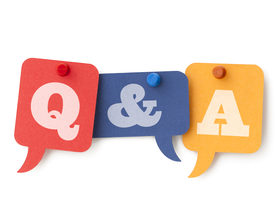Q: How about the Q&A session?
A: We’ll put the mic and that’s enough.
This sounds familiar, doesn't it? Look, we get it. You are already under pressure dealing with thousands of planning details. That's why it's normal to ignore something that should happen by itself.
You have a speaker, enough audience, and a moderator. The Q&A session should go smoothly, right? Maybe, but if you want to be sure that you'll have a high-quality event, a simple Q&A session is not enough. You have to plan it.
Why?
According to the professor Chris Ryan, the nowadays events are successful only if they can generate an emotional intensity. Therefore, apart from the perfect logistics, an event manager should also focus on the experiences he or she wants to provide.
One of the features of unforgettable event experiences, as researcher Graham Berridge notes, is the design of engaging environments. Q&A sessions are perfect opportunities to level up the attendees’ experience, by encouraging them to interact with the speakers. So how can you improve the Q&A session at your next event?
1. Crowd-source the questions before the Q&A
It’s always good to be prepared for the Q&A session. To do so, you have two options. One of them is the use of social media. Before the event, announce your followers that you are collecting questions for your speakers. Also, if you don’t want to receive off-topic questions, specify the professional expertise of your guests and the topic of the discussion. This way you increase the possibility of receiving good feedback. Another way of crowd-sourcing the questions is by engaging the attendees before the Q&A session. Ask them to articulate their questions via an event application. This way, the less talkative public will have the opportunity to interact with the speaker without feeling exposed. It’s a good way to boost up their experience.
2. Allow people some time for reflection
Attendees need time to articulate their questions and gather the courage to speak in front of everyone. An interesting approach is to let the public express their thoughts and questions in small groups. After what, they can interact with the speaker. This strategy is a great way for the attendees to obtain validation and feel even more empowered to ask the question. Also, it improves the interaction between the attendees.
3. Pre-load some questions to initiate the discussion
Start the Q&A session, being the one who initiates the discussion. Ask the speaker some questions and let him or her reply. People will follow your example, feeling more encouraged to talk. By doing so, you’ll be able to mark the dialogue. Also, after asking the first question, you’ll understand the answering style of your speaker. Is he or she keeping it short? Do you need to follow up with one or two more questions to clarify the answer? Or maybe they spend too much time answering? By knowing that, you’ll be able to guide successfully the session.
4. Let people pick up the most burning topics
Encourage people to co-create the event and decide which topics they want to cover. Ask them to come up with questions in small groups and vote for the most important one. Also, you can do that by using event apps which enable people to vote for the most relevant questions. This way, the attendees will have a great opportunity to co-create the experience of the Q&A session.
5. Dedicate more time for Q&A
Q&A sessions are amazing for knowledge transference. You never know how one question can add incredible value to the event. That's why it's important to dedicate a proper amount of time to these sessions, when designing an event. Before the Q&A, let the attendees know how much time they have to articulate the questions. Don’t rush the experience. Don’t forget that the keynote speech is only half of the experience. What counts is the interaction and the engagement your attendees will experience.
6. Don't forget the mic!
Just kidding! Forget the mic! Kidding again! Throw the mic! Make it fun! Feel free to upgrade your event using throwable microphones or app based microphones. This way you’ll add a relaxed tone to your Q&A session, making people feel more comfortable with asking questions.
7. Experiment with mid-presentation Q&A
Boost up the interaction experience. Transform the monologue of the speaker into a dialogue. For that, you have to count with speaker’s willingness to engage the public and to agree with the mid-presentation questions. There is a big difference between hearing a talk and engaging in a dialogue. No more yawns. By asking the attendees to interact, they will feel more focused and alert. Also, they will feel empowered to guide the direction of the session.
Wrap Up
There are different ways to improve the Q&A sessions. You have different levels of action. First of all, you can control the time when the attendees will ask their questions. Secondly, you can use technology to make the Q&A sessions more interactive and help those who feel uneasy with the public speaking to engage with the rest. Thirdly, you can offer your attendees the opportunity to co-create the event experience. They can decide which topics are important for them, this way guiding the session. Use these strategies wisely and and you’ll be one step forward in creating memorable experiences for your attendees.





